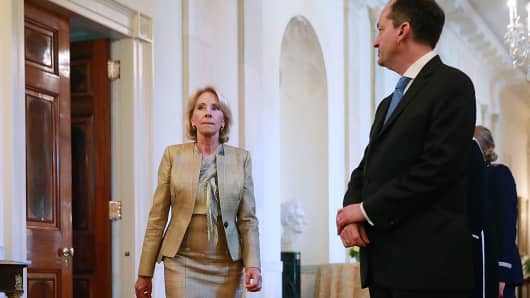Take, for example, the Trump Administration's proposal to merge the Education and Labor Departments. As Seth Harris, my predecessor as Deputy Secretary of Labor explained, merging these departments is "a solution in search of a problem."
Yes, there is a natural synergy between the two agencies' education and training programs. But the overwhelming majority of the Labor Department's 16,000 employees focus on protecting workers' health and safety, wages, civil rights, and pensions – or on collecting data about labor markets.
A proposal to streamline federal workforce preparation efforts is not unreasonable, but it would have to go well beyond the Education and Labor Departments. In 2011, the Government Accountability Office found training programs spread out at nine different federal agencies. The Department of Veterans Affairs, for instance, provides education and training benefits for veterans and their family members, as well as vocational rehabilitation programs and career counseling.
One reason why government reorganizations have failed in the past is because of resistance on Capitol Hill. Members of Congress who have created or supported government programs understandably resist their consolidation or elimination.
Shifting programs to new agencies also runs into opposition from congressional committees that are loath to give up their jurisdiction over these programs. And powerful stakeholders like veterans have institutional reasons to prefer the status quo.
However, moving around agencies isn't the only way to improve the functioning of government. Donald Trump could take several steps right now that would be far more impactful than offering yet another reorganization plan.
First, he could focus on finding competent people to fill senior-level vacancies. Of the 670 positions requiring Senate confirmation, there is no nominee for 188 of those positions. For instance, despite the nationwide opioid epidemic, there are no nominees for the top two positions at the Drug Enforcement Administration. And as the federal government gears up for the 2020 census, there is no nominee to run the Census Bureau.
In filling these critical positions, the Trump Administration would do well to ensure that its nominees are focused on serving the public, rather than enriching themselves. The rampant ethical issues of Cabinet members like EPA Administrator Scott Pruitt do more to damage the functioning of government than a few duplicative programs.
Second, if Trump wants to help government better provide services, he could stop proposing steep cuts to federal programs that provide critical food, housing, and medical assistance to millions of Americans. Trump would also do well to stop tweeting that domestic programs are a "waste" of money and "Dem giveaways."
Lastly, the federal government would work a lot better if the president stopped marginalizing science in policy decisions and curbed the exodus of subject-matter experts, especially scientists. At the EPA alone, more than 200 scientists left in the first year of the Trump Administration.
Given that none of these changes are likely to happen with this president, we should treat his government reorganization proposal like the rest of Trump policy agenda: just a lot of hot air.
Commentary by Chris Lu, who served in the Obama Administration as White House Cabinet Secretary and Deputy Secretary of Labor. He is now a senior fellow at the University of Virginia Miller Center. Follow him on Twitter at @ChrisLu44.
For more insight from CNBC contributors, follow
@CNBCopinion
on Twitter.


